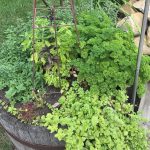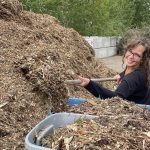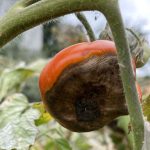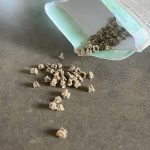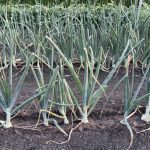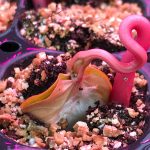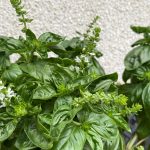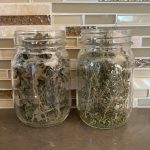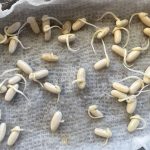How to Stop Cucumber Leaves from Turning Yellow
Cucumbers are a delicious and healthy addition to any garden, but sometimes, yellowing leaves can hinder their growth and ruin the crop.
Yellowing leaves can be a symptom of a wide range of problems, from nutrient deficiencies, watering practices, and environmental influences to pests and diseases.
In this post, we’ll explore the various causes of yellowing leaves in cucumber plants and give tips on preventing them.

Want the inside scoop on more gardening tips? Get early access to all my blogs and exclusive content by signing up for my newsletter!
How to Spot Cucumber Leaves Turning Yellow Before it’s Irreversible

Plants talk to us and convey information about their health through their leaves.
Cucumbers are known for their vibrant green foliage, so when the leaves start to turn yellow, it can indicate a problem with the plant’s health.
To get started, check your cucumbers daily. This doesn’t have to be a deep inspection but a quick, intentional look when evaluating their watering needs.
Healthy cucumber leaves should be a solid, deep green colour.
Now, let’s dig into the various factors that can contribute to yellowing cucumber leaves and explore effective prevention methods.
Reasons Your Cucumber Leaves are Turning Yellow & How to Stop Them
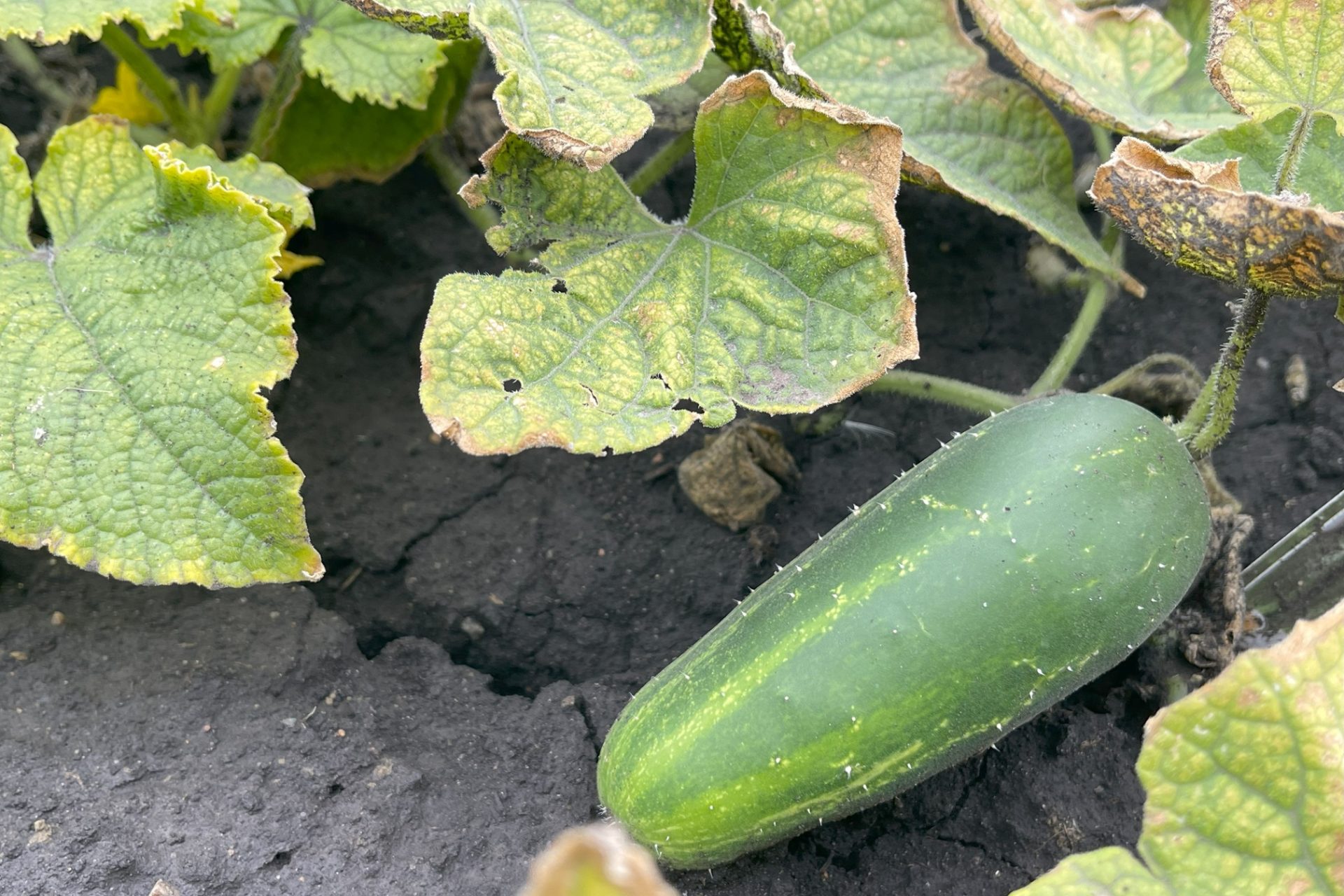
Cucumber leaves may turn yellow for several reasons, from innocuous and metabolic causes to pests or diseases.
1. Cucumber Leaf Age Causes Yellowing
As cucumber leaves age, as with all leaves, their capacity to photosynthesize decreases, and they begin to pale. As the aging process continues, they turn brown, dry, and crispy.
Leaves age from the bottom of the vine first, and they age successively upward because the oldest leaves are at the bottom.
There’s nothing that can be done about this normal life process; just remove the leaves when they start to turn brown to prevent them from molding and causing any infections for the rest of the plant.
2. Environmental Factors That Contribute to Yellowing Leaves
While it’s easy to blame plant diseases or pests, it’s important to consider environmental factors that can contribute to this problem, so let’s explore those first.
One of the primary environmental factors that can cause yellowing leaves is inadequate sunlight.
Cucumbers thrive in full sunlight, typically requiring at least 6-8 hours of direct sunlight each day.
If your cucumber plants are not receiving enough sunlight, their leaves may start to yellow.
To prevent this, ensure that your cucumber plants are positioned where they receive ample sunlight throughout the day.
Another environmental factor is related to watering practices.

Overwatering or underwatering can both lead to yellowing leaves. Cucumber plants require consistent and adequate moisture to thrive.
Overwatering can lead to root rot and nutrient deficiencies, which cause the leaves to turn yellow. This is discussed in more detail below.
On the other hand, underwatering can cause dehydration and stress, resulting in yellowing leaves.
To prevent this issue, striking the right balance by monitoring soil moisture levels and maintaining consistently moist soil.
Temperature extremes can also play a role in the yellowing of cucumber leaves.
Originally from the tropics, cucumbers are heat lovers and they grow best in warm temperatures between 21-29°C (70-85°F).
If temperatures drop below this range, or if there are sudden temperature fluctuations, the leaves may start to yellow.
Protecting your cucumber plants from extreme temperatures, such as providing shade cover during hot summer days as well as during cold spells, can help maintain healthy green leaves.
Greenhouses are an excellent option for growing cucumbers.
3. Nutrient Deficiencies and Imbalances That Lead to Yellowing Cucumber Leaves

Soil nutrient deficiencies can contribute to yellowing leaves.
Cucumbers require a balanced supply of essential nutrients, including nitrogen, phosphorus, and potassium.
If the soil lacks these nutrients or has an imbalance, it can manifest in yellowing leaves.
Conducting a soil test and amending the soil with organic fertilizers or compost can help ensure your cucumber plants can access the necessary nutrients.
Nutrient deficiencies are discussed in more detail below.
One of the most common reasons for yellowed leaves in cucumbers is a lack of nitrogen.
Nitrogen is an essential nutrient for plant growth and is responsible for the vibrant green leaf colour.
A nitrogen deficiency can result in pale yellowing leaves, starting from the older leaves and progressing upwards.
To fix this issue, a nitrogen-rich fertilizer should be applied to provide the necessary nutrients to the plant.

Want the inside scoop on more gardening tips? Get early access to all my blogs and exclusive content by signing up for my newsletter!
Another possible nutrient deficiency that can lead to yellowing leaves is a lack of magnesium.
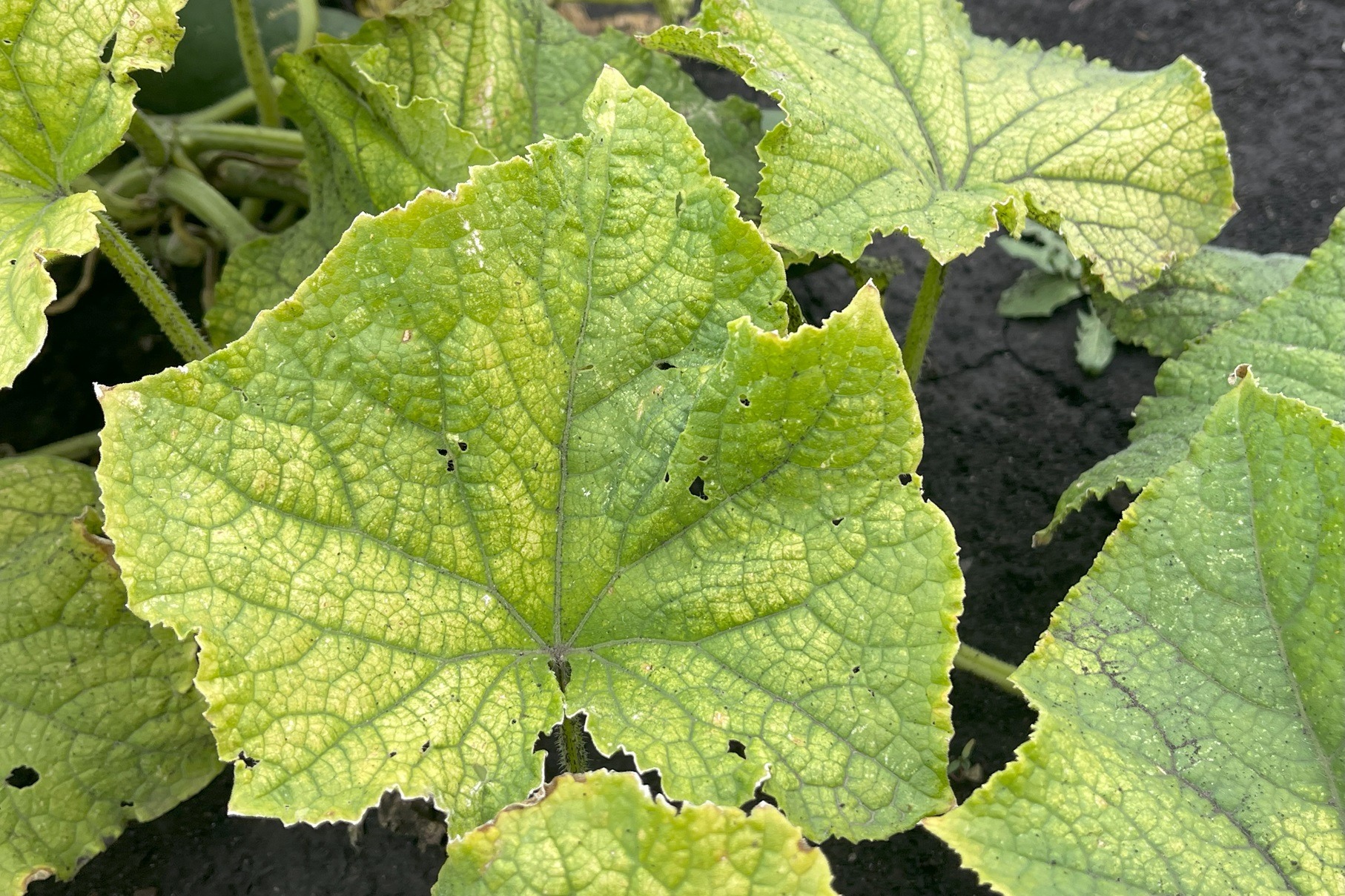
Magnesium is crucial for chlorophyll production, which is necessary for photosynthesis. Without sufficient magnesium, the leaves may develop interveinal chlorosis, where the veins remain green while the areas between the veins turn yellow.
Magnesium sulphate or a foliar spray containing magnesium should be applied to the affected plants to address this deficiency.
In some cases, yellowing leaves may also result from other nutrient imbalances.
For instance, excessive potassium levels can interfere with the plant’s ability to absorb other nutrients, leading to deficiencies and yellowing foliage.
To prevent this, maintain a balanced nutrient regimen and ensure that all essential elements are provided in appropriate quantities.
Good fertilizer options for cucumbers include 20-20-20, 10-10-10, or organic fertilizers like 5-7-6.
Related: How to Understand Fertilizer Labels, What is the Best Way to Fertilize Plants?
4. Overwatering and Poor Drainage: Another Culprit Behind Yellowing Cucumber Leaves

Overwatering and poor drainage, leading to root rot, can often cause yellowing leaves in cucumber plants. While it’s important to provide enough water to keep your plants hydrated, excessive watering can lead to waterlogged soil and suffocate the roots.
This, in turn, disrupts the nutrient uptake process, resulting in yellowing leaves.
To prevent overwatering, note that cucumbers require consistent moisture but do not thrive in wet conditions.
To ensure that the soil is moist but not saturated, always check if your plants need watering before you water.
I have never been a fan of stringent watering schedules or watering timers, as they can lead to oversaturation. We tend not to check the soil often enough, and the plant gets overwatered.
An effective way to check soil hydration is by sticking the entire length of your index finger into the soil. If it feels dry at the first or second knuckle, it’s time to water.
Additionally, proper drainage is essential to prevent waterlogging because good drainage ensures excess water can freely flow out of the soil, allowing oxygen to reach the roots.
If your cucumber plants are in containers, ensure that there are drainage holes at the bottom to allow water to escape and empty catchment pans when they fill.
For in-ground and container planting, consider incorporating organic materials such as compost or worm castings into the soil to improve drainage capabilities. Avoid peat moss, as it can cause soil to become acidic.
All of these practices lead to healthy roots, and healthy roots lead to healthy foliage, so it’s important to strike a balance between providing enough water and avoiding waterlogged conditions.

Want the inside scoop on more gardening tips? Get early access to all my blogs and exclusive content by signing up for my newsletter!
5. Pests and Diseases That Cause Yellowing Leaves in Cucumber Plants

Cucumber plants can sometimes fall victim to various pests and diseases, leading to the unsightly yellowing of their leaves.
One common culprit behind yellowing leaves is the cucumber beetle.
These tiny, striped pests feed on the leaves and transmit bacterial wilt, a disease that can quickly devastate your entire cucumber crop.
To prevent infestation, consider using row covers or insecticidal sprays specifically designed to target cucumber beetles.
Another pest to watch out for is the aphid.
These tiny insects cluster on the undersides of leaves, sucking out plant sap and secreting a sticky substance known as honeydew.
Aphids can cause the leaves to turn yellow and curl, hindering the overall growth of your cucumber plants.
Introducing natural predators like ladybugs, blasting them off with a strong water stream, and using insecticidal soaps can help effectively control aphid populations.
Fungal diseases, such as powdery mildew and downy mildew, can also contribute to yellowing leaves in cucumber plants.
Powdery mildew appears as a powdery white coating on the leaves, while downy mildew causes yellow patches that eventually turn brown.
To prevent these diseases, ensure proper air circulation around your plants, avoid overhead watering, and apply fungicides if necessary.
Related: How to Grow Great Cucumbers in Alberta
Avoid Yellowing Leaves on Cucumber Plants with Proper Care
Yellow leaves on cucumber plants can be a sign of various issues, from nutrient deficiencies to improper watering or pest infestations. To avoid this, ensure your plants receive balanced fertilization, consistent watering, and proper sunlight. Regularly inspect your cucumber plants for pests or disease, and take swift action if any signs appear. With the right care and attention, your cucumbers can thrive, producing lush, green foliage and a bountiful harvest.
For more expert gardening tips and to stay informed on the best practices for maintaining a healthy garden, sign up for my newsletter today! Happy gardening!
More to Explore:
- The Ultimate Companion Planting Guide from A-Z
- The Vegetable Planting Chart
- How to Grow the Best Tomatoes in Alberta
- Determinate vs Indeterminate Tomatoes: A Guide to Pruning
- Transplanting Vegetable Seedlings
- How to Grow Great Onions in Alberta and on the Prairies
- The Complete Guide to Raised Bed Planting
- How to Grow Beets in Alberta
- How to Grow Basil in Alberta
- How to Grow Garlic in Alberta and on the Prairies
©Sharon Wallish Murphy ©Gardening with Sharon




